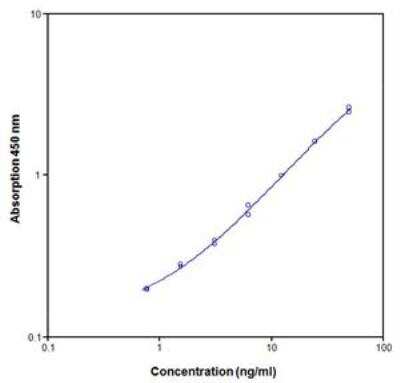Human 4-1BB/TNFRSF9/CD137 ELISA Kit (Colorimetric)
Novus Biologicals, part of Bio-Techne | Catalog # NBP1-91278

Key Product Details
Sample Type & Volume Required Per Well
Cell culture supernatant, serum (50 uL)
Sensitivity
0.2 ng/mL
Assay Range
0.78 - 50 ng/mL
Product Specifications
Assay Type
Sandwich ELISA
Kit Type
ELISA Kit (Colorimetric)
Reactivity
Human
Specificity
The interference of circulating factors of the immune systemwas evaluated by spiking these proteins at physiologically relevant concentrations into a human 4-1BB/TNFRSF9/CD137 positive serum. There was no crossreactivity detected.
Description
The human sCD137 ELISA is an enzyme-linked immunosorbent assay for the quantitative detection of human sCD137.
Precision
Intra-Assay Precision (Precision within an assay) CV% < 7.10%
Inter-Assay Precision (Precision between assays) CV% < 9.90%
Recovery for Human 4-1BB/TNFRSF9/CD137 ELISA Kit (Colorimetric)
Recovery
90%
Scientific Data Images for Human 4-1BB/TNFRSF9/CD137 ELISA Kit (Colorimetric)
4-1BB/TNFRSF9/CD137 ELISA Kit [NBP1-91278] - Data for Human sCD137 (s4-1BB) Platinum ELISA
Kit Contents for Human 4-1BB/TNFRSF9/CD137 ELISA Kit (Colorimetric)
- Adhesive Films
- Aluminium pouch(es) with a Microwell Plate coated with monoclonal antibody to human sCD137
- Assay Buffer Concentrate 20x (PBS with 1% Tween 20 and 10% BSA)
- Biotin-Conjugate anti-human sCD137 polyclonal antibody
- Human sCD137 Standard lyophilized, 100 ng/ml upon reconstitution
- Sample Diluent
- Stop Solution (1M Phosphoric acid)
- Streptavidin-HRP
- Substrate Solution (tetramethyl-benzidine)
- Wash Buffer Concentrate 20x (PBS with 1% Tween 20)
Preparation and Storage
Shipping
The product is shipped at ambient temperature. Upon receipt, store it immediately at the temperature recommended below.
Stability & Storage
Storage of components varies. See protocol for specific instructions.
Background: 4-1BB/TNFRSF9/CD137
References
1. Etxeberria, I., Glez-Vaz, J., Teijeira, A., & Melero, I. (2020). New emerging targets in cancer immunotherapy: CD137/4-1BB costimulatory axis. ESMO open, 4(Suppl 3), e000733. https://doi.org/10.1136/esmoopen-2020-000733
2. Chester, C., Sanmamed, M. F., Wang, J., & Melero, I. (2018). Immunotherapy targeting 4-1BB: mechanistic rationale, clinical results, and future strategies. Blood, 131(1), 49-57. https://doi.org/10.1182/blood-2017-06-741041
3. Uniport (Q07011)
4. Chester, C., Ambulkar, S., & Kohrt, H. E. (2016). 4-1BB agonism: adding the accelerator to cancer immunotherapy. Cancer Immunology, Immunotherapy: CII, 65(10), 1243-1248. https://doi.org/10.1007/s00262-016-1829-2
5. Zapata, J. M., Perez-Chacon, G., Carr-Baena, P., Martinez-Forero, I., Azpilikueta, A., Otano, I., & Melero, I. (2018). CD137 (4-1BB) signalosome: complexity is a matter of TRAFs. Frontiers in Immunology, 9, 2618. https://doi.org/10.3389/fimmu.2018.02618
Alternate Names
41BB, CD137, ILA, TNFRSF9
Gene Symbol
TNFRSF9
Additional 4-1BB/TNFRSF9/CD137 Products
Product Documents for Human 4-1BB/TNFRSF9/CD137 ELISA Kit (Colorimetric)
Product Specific Notices for Human 4-1BB/TNFRSF9/CD137 ELISA Kit (Colorimetric)
This product is for research use only and is not approved for use in humans or in clinical diagnosis. ELISA Kits are guaranteed for 6 months from date of receipt.
